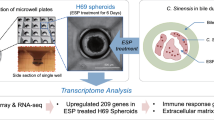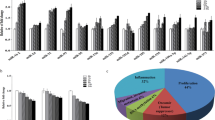Abstract
Clonorchiasis is associated with bile duct malignancy and the subsequent development of cholangiocarcinoma. Although this is likely caused by adult Clonorchis sinensis and its excretory–secretory products (ESP), the precise molecular mechanisms remain obscure. To evaluate the effect of C. sinensis infection on differential gene expression in host hepatocytes, we examined the kinetics of changes in gene expression in the human cholangiocarcinoma cell line HuCCT1 treated with ESP at different times. Using complementary DNA microarrays containing 23,920 human genes of known function, we initially identified 435 genes altered by ESP treatment. Of these, 31 were up-regulated and 35 were down-regulated more than twofold in a time-dependent manner following ESP treatment. Clustering of these genes by function revealed that several were involved in the cell cycle, oncogenesis, protein modification, immunity, signal transduction, cell structure, and developmental processes. These findings should provide a fundamental basis for further analysis of the molecular pathways and mechanisms involved in C. sinensis infection of host cells.





Similar content being viewed by others
References
Callus BA, Verhagen AM, Vaux DL (2006) Association of mammalian sterile twenty kinases, Mst1 and Mst2, with hSalvador via C-terminal coiled-coil domains, leads to its stabilization and phosphorylation. FEBS J 273:4264–4276
Carlyle JR, Jamieson AM, Gasser S, Clingan CS, Arase H, Raulet DH (2004) Missing self-recognition of Ocil/Clr-b by inhibitory NKR-P1 natural killer cell receptors. Proc Natl Acad Sci U S A 101:3527–3532
Cervi L, Masih DT (1997) Inhibition of spleen cell proliferative response to mitogens by excretory–secretory antigens of Fasciola hepatica. Int J Parasitol 27:573–579
Chaib H, Cockrell EK, Rubin MA, Macoska JA (2001) Profiling and verification of gene expression patterns in normal and malignant human prostate tissues by cDNA microarray analysis. Neoplasia 3:43–52
Chen SJ, Ning H, Ishida W, Sodin-Semrl S, Takagawa S, Mori Y, Varga J (2006) The early-immediate gene EGR-1 is induced by transforming growth factor-beta and mediates stimulation of collagen gene expression. J Biol Chem 281:21183–21197
Choi D, Lim JH, Lee KT, Lee JK, Choi SH, Heo JS, Jang KT, Lee NY, Kim S, Hong ST (2006) Cholangiocarcinoma and Clonorchis sinensis infection: a case-control study in Korea. J Hepatol 44:1066–1073
Crompton DW (1999) How much human helminthiasis is there in the world? J Parasitol 85:397–403
Fukushima Y, Ohnishi T, Arita N, Hayakawa T, Sekiguchi K (1998) Integrin alpha3beta1-mediated interaction with laminin-5 stimulates adhesion, migration and invasion of malignant glioma cells. Int J Cancer 76:63–72
Gillott DJ, Iles RK, Chard T (1996) The effects of beta-human chorionic gonadotrophin on the in vitro growth of bladder cancer cell lines. Br J Cancer 73:323–326
Hao J, Yang Y, McDaniel KM, Dalkin BL, Cress AE, Nagle RB (1996) Differential expression of laminin 5 (alpha 3 beta 3 gamma 2) by human malignant and normal prostate. Am J Pathol 149:1341–1349
Hong SJ, Kim TY, Gan XX, Shen LY, Sukontason K, Sukontason K, Kang SY (2002) Clonorchis sinensis: glutathione S-transferase as a serodiagnostic antigen for detecting IgG and IgE antibodies. Exp Parasitol 101:231–233
Iizuka K, Naidenko OV, Plougastel BF, Fremont DH, Yokoyama WM (2003) Genetically linked C-type lectin-related ligands for the NKRP1 family of natural killer cell receptors. Nat Immunol 4:801–807
Jakobsson PJ, Morgenstern R, Mancini J, Ford-Hutchinson A, Persson B (2000) Membrane-associated proteins in eicosanoid and glutathione metabolism (MAPEG). A widespread protein superfamily. Am J Respir Crit Care Med 161:S20–S24
Jinawath N, Chamgramol Y, Furukawa Y, Obma K, Tsunoda T, Sripa B, Pairojkul C, Nakamura Y (2006) Comparison of gene expression profiles between Opisthorchis viverrini and non-Opisthorchis viverrini associated human intrahepatic cholangiocarcinoma. Hepatology 44:1025–1038
Kalma Y, Marash L, Lamed Y, Ginsberg D (2001) Expression analysis using DNA microarrays demonstrates that E2F-1 up-regulates expression of DNA replication genes including replication protein A2. Oncogene 20:1379–1387
Kaneko-Ishino T, Kuroiwa Y, Miyoshi N, Kohda T, Suzuki R, Yokoyama M, Viville S, Barton SC, Ishino F, Surani MA (1995) Peg1/Mest imprinted gene on chromosome 6 identified by cDNA subtraction hybridization. Nat Genet 11:52–59
Kang TH, Yun DH, Lee EH, Chung YB, Bae YA, Chung JY, Kang I, Kim J, Cho SY, Kong Y (2004) A cathepsin F of adult Clonorchis sinensis and its phylogenetic conservation in trematodes. Parasitology 128:195–207
Kelner MJ, Bagnell RD, Montoya MA, Estes LA, Forsberg L, Morgenstern R (2000) Structural organization of the microsomal glutathione S-transferase gene (MGST1) on chromosome 12p13.1-13.2. Identification of the correct promoter region and demonstration of transcriptional regulation in response to oxidative stress. J Biol Chem 275:13000–13006
Kohda M, Hoshiya H, Katoh M, Tanaka I, Masuda R, Takemura T, Fujiwara M, Oshimura M (2001) Frequent loss of imprinting of IGF2 and MEST in lung adenocarcinoma. Mol Carcinog 31:184–191
Li S, Chung BS, Choi MH, Hong ST (2004) Organ-specific antigens of Clonorchis sinensis. Korean J Parasitol 42:169–174
Martin KJ, Kwan CP, Nagasaki K, Zhang X, O’Hare MJ, Kaelin CM, Burgeson RE, Pardee AB, Sager R (1998) Down-regulation of laminin-5 in breast carcinoma cells. Mol Med 4:602–613
Miyagiwa M, Ichida T, Tokiwa T, Sato J, Sasaki H (1989) A new human cholangiocellular carcinoma cell line (HuCC-T1) producing carbohydrate antigen 19/9 in serum-free medium. In vitro Cell Dev Biol 25:503–510
Modestou M, Puig-Antich V, Korgaonkar C, Eapen A, Quelle DE (2001) The alternative reading frame tumor suppressor inhibits growth through p21-dependent and p21-independent pathways. Cancer Res 62:3145–3150
Morris L, Allen KE, La Thangue NB (2000) Regulation of E2F transcription by cyclin E-Cdk2 kinase mediated through p300/CBP co-activators. Nat Cell Biol 2:232–239
Orian-Rousseau V, Aberdam D, Rousselle P, Messent A, Gavrilovic J, Meneguzzi G, Kedinger M, Simon-Assmann P (1998) Human colonic cancer cells synthesize and adhere to laminin-5. Their adhesion to laminin-5 involves multiple receptors among which is integrin alpha2beta1. J Cell Sci 111:1993–2004
Padmanabhan V, Callas P, Philips G, Trainer TD, Beatty BG (2004) DNA replication regulation protein Mcm7 as a marker of proliferation in prostate cancer. J Clin Pathol 57:1057–1062
Papachristou GI, Schoedel KE, Ramanathan R, Rabinovitz M (2005) Clonorchis sinensis-associated cholangiocarcinoma: a case report and review of the literature. Dig Dis Sci 50:2159–2162
Parise P, Finocchiaro G, Masciadri B, Quarto M, Francois S, Mancuso F, Muller H (2006) Lap2alpha expression is controlled by E2F and deregulated in various human tumors. Cell Cycle 5:1331–1341
Pedersen IS, Dervan PA, Broderick D, Harrison M, Miller N, Delany E, O’Shea D, Costello P, McGoldrick A, Keating G, Tobin B, Gorey T, McCann A (1999) Frequent loss of imprinting of PEG1/MEST in invasive breast cancer. Cancer Res 59:5449–5451
Pedersen IS, Dervan P, McGoldrick A, Harrison M, Ponchel F, Speirs V, Isaacs JD, Gorey T, McCann A (2002) Promoter switch: a novel mechanism causing biallelic PEG1/MEST expression in invasive breast cancer. Hum Mol Genet 11:1449–1453
Reimer D, Sadr S, Wiedemair A, Goebel G, Concin N, Hofstetter G, Marth C, Zeimet AG (2006) Expression of the E2F family of transcription factors and its clinical relevance in ovarian cancer. Ann N Y Acad Sci 1091:270–281
Ren B, Yu G, Tseng GC, Cieply K, Gavel T, Nelson J, Michalopoulos G, Yu YP, Luo JH (2006) MCM7 amplification and overexpression are associated with prostate cancer progression. Oncogene 25:1090–1098
Rim HJ (2005) Clonorchiasis: an update. J Helminthol 79:269–281
Serradell MC, Guasconi L, Cervi L, Chiapello LS, Masih DT (2007) Excretory-secretory products from Fasciola hepatica induce eosinophil apoptosis by a caspase-dependent mechanism. Vet Immunol Immunopathol 117:197–208
Shi SQ, Xu L, Zhao G, Yang Y, Peng JP (2006) Apoptosis and tumor inhibition induced by human chorionic gonadotropin beta in mouse breast carcinoma. J Mol Med 84:933–941
Tapon N, Harvey KF, Bell DW, Wahrer DC, Schiripo TA, Haber DA, Hariharan IK (2002) Salvador promotes both cell cycle exit and apoptosis in Drosophila and is mutated in human cancer cell lines. Cell 110:467–478
Thiel G, Cibelli G (2002) Regulation of life and death by the zinc finger transcription factor Egr-1. J Cell Physiol 193:287–292
Thorburn A (2004) Death receptor-induced cell killing. Cell Signal 16:139–144
Thuwajit C, Thuwajit P, Kaewkes S, Sripa B, Uchida K, Miwa M, Wongkham S (2004) Increased cell proliferation of mouse fibroblast NIH-3T3 in vitro induced by excretory/secretory product(s) from Opisthorchis viverrini. Parasitology 129:455–464
Watanapa P, Watanapa WB (2002) Liver fluke-associated cholangiocarcinoma. Br J Surg 89:962–970
Acknowledgment
The authors thank Macrogen, Inc. (Seoul, Korea) for technical assistance with cDNA microarrays. This work was supported by a grant (NIH-4847-302-260-00) from the National Institute of Health, Ministry of Health and Welfare, Korea.
Author information
Authors and Affiliations
Corresponding authors
Rights and permissions
About this article
Cite this article
Pak, J.H., Kim, DW., Moon, J.H. et al. Differential gene expression profiling in human cholangiocarcinoma cells treated with Clonorchis sinensis excretory-secretory products. Parasitol Res 104, 1035–1046 (2009). https://doi.org/10.1007/s00436-008-1286-8
Received:
Accepted:
Published:
Issue Date:
DOI: https://doi.org/10.1007/s00436-008-1286-8




